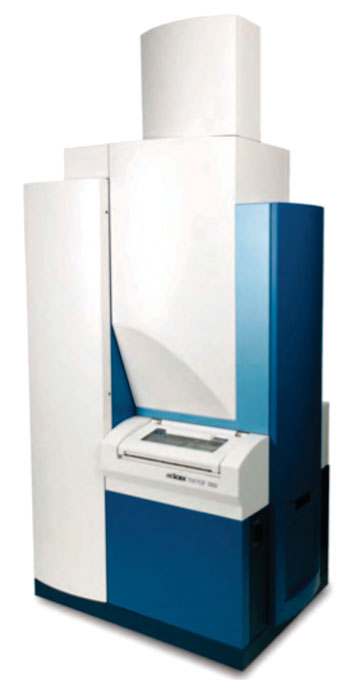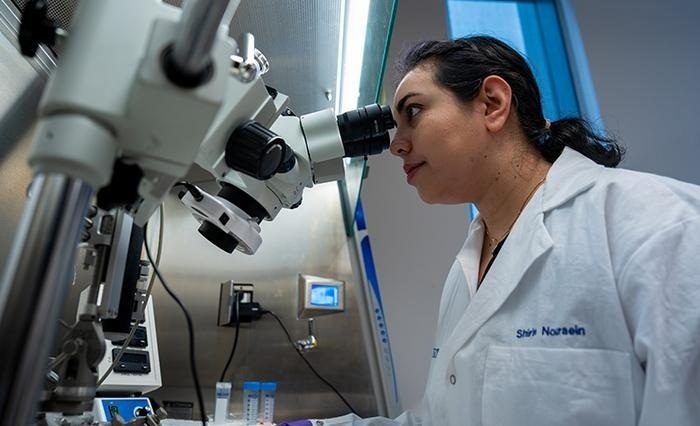New Method Diagnoses Deadly Fungal Lung Infection
|
By LabMedica International staff writers Posted on 29 Dec 2015 |

Image: The AB Sciex 5800 MALDI TOF/TOF mass spectrometer (Photo courtesy of Sciex).
A new way has been discovered for the early detection of a potentially deadly fungal infection in patients with suppressed immune systems such as those being treated for leukemia or have had an organ transplant.
Patients receiving leukemia chemotherapy treatments, bone marrow stem cell transplants or lung transplants are some of those at risk for serious infection by the disease-causing Aspergillus fungus, a common mold in the environment that easily becomes airborne. When inhaled, the mold colonizes the respiratory tract and in patients with immune suppression from their chemotherapy treatment, the mold invades into the bloodstream where it spreads and infects several organs including the liver, lungs and brain.
A multidisciplinary team led by scientists at The University of Texas Medical Branch (Galveston, TX, USA) enrolled patients undergoing chemotherapy, stem cell transplantation and lung transplantation in a multisite prospective observational trial. Proven and probable invasive pulmonary aspergillosis (IPA) cases and matched controls were subjected to discovery proteomics analyses using a biofluid analysis platform, fractionating plasma into reproducible protein and peptide pools.
Of the 61 IPA cases, serum galactomannan (GM) was assayed in 60, of which 36 tests were positive. Bronchoalveolar lavage GM was assayed in 35 cases of which 30 were positive. A positive serum GM was the only mycological criteria in 22 of the 61 cases. Independent testing of GM was performed on all IPA cases using serum collected on the same day as samples used for proteomics analysis. Those who developed probable or proven IPA where selected for subsequent proteomics studies.
For the 2D gel electrophoresis (2DE) spots that were significantly differentially expressed were picked robotically, trypsin-digested, and peptides identified by MALDI TOF/TOF (AB Sciex 5800; Foster City, CA, USA). Plasma concentrations of interleukin (IL)-6, -10, tumor necrosis factor (TNF)-α, plasminogen activator inhibitor (PAI)-1, Factor VIII, and Von Willebrand factor (vWF) were assayed by sandwich ELISA (Bioplex; Bio-Rad, Hercules, CA, USA). The Platelia Aspergillus enzyme immunoassay (EIA) (Bio-Rad Laboratories; Redmond, WA, USA;) was also performed.
From 556 spots identified by 2D gel electrophoresis, 66 differentially expressed post-translationally modified plasma proteins were identified in the leukemic subgroup only. This protein group was rich in complement components, acute-phase reactants and coagulation factors. Low molecular weight peptides corresponding to abundant plasma proteins were identified. A candidate marker panel of host response (nine plasma proteins, four peptides), fungal polysaccharides (galactomannan), and cell wall components (β-D glucan, BG) were selected by statistical filtering for patients with leukemia as a primary underlying diagnosis. The test results for the mold were different for each group of patients, so future commercial diagnostic tests using this technology should be tailored for different medical conditions commonly linked with this infection.
The authors concluded that they had confirmed, and evaluated a multicomponent predictive panel for the presence of IPA in a prospective cohort of immunocompromised patients in a multicenter registry. Two important findings are that host response proteins contribute independent information to that of GM or BG, and that diagnostic host response proteins of IPA are significantly influenced by the primary underlying disease. The study was published on November 18, 2015, in the journal Public Library of Science ONE.
Related Links:
The University of Texas Medical Branch
AB Sciex
Bio-Rad
Patients receiving leukemia chemotherapy treatments, bone marrow stem cell transplants or lung transplants are some of those at risk for serious infection by the disease-causing Aspergillus fungus, a common mold in the environment that easily becomes airborne. When inhaled, the mold colonizes the respiratory tract and in patients with immune suppression from their chemotherapy treatment, the mold invades into the bloodstream where it spreads and infects several organs including the liver, lungs and brain.
A multidisciplinary team led by scientists at The University of Texas Medical Branch (Galveston, TX, USA) enrolled patients undergoing chemotherapy, stem cell transplantation and lung transplantation in a multisite prospective observational trial. Proven and probable invasive pulmonary aspergillosis (IPA) cases and matched controls were subjected to discovery proteomics analyses using a biofluid analysis platform, fractionating plasma into reproducible protein and peptide pools.
Of the 61 IPA cases, serum galactomannan (GM) was assayed in 60, of which 36 tests were positive. Bronchoalveolar lavage GM was assayed in 35 cases of which 30 were positive. A positive serum GM was the only mycological criteria in 22 of the 61 cases. Independent testing of GM was performed on all IPA cases using serum collected on the same day as samples used for proteomics analysis. Those who developed probable or proven IPA where selected for subsequent proteomics studies.
For the 2D gel electrophoresis (2DE) spots that were significantly differentially expressed were picked robotically, trypsin-digested, and peptides identified by MALDI TOF/TOF (AB Sciex 5800; Foster City, CA, USA). Plasma concentrations of interleukin (IL)-6, -10, tumor necrosis factor (TNF)-α, plasminogen activator inhibitor (PAI)-1, Factor VIII, and Von Willebrand factor (vWF) were assayed by sandwich ELISA (Bioplex; Bio-Rad, Hercules, CA, USA). The Platelia Aspergillus enzyme immunoassay (EIA) (Bio-Rad Laboratories; Redmond, WA, USA;) was also performed.
From 556 spots identified by 2D gel electrophoresis, 66 differentially expressed post-translationally modified plasma proteins were identified in the leukemic subgroup only. This protein group was rich in complement components, acute-phase reactants and coagulation factors. Low molecular weight peptides corresponding to abundant plasma proteins were identified. A candidate marker panel of host response (nine plasma proteins, four peptides), fungal polysaccharides (galactomannan), and cell wall components (β-D glucan, BG) were selected by statistical filtering for patients with leukemia as a primary underlying diagnosis. The test results for the mold were different for each group of patients, so future commercial diagnostic tests using this technology should be tailored for different medical conditions commonly linked with this infection.
The authors concluded that they had confirmed, and evaluated a multicomponent predictive panel for the presence of IPA in a prospective cohort of immunocompromised patients in a multicenter registry. Two important findings are that host response proteins contribute independent information to that of GM or BG, and that diagnostic host response proteins of IPA are significantly influenced by the primary underlying disease. The study was published on November 18, 2015, in the journal Public Library of Science ONE.
Related Links:
The University of Texas Medical Branch
AB Sciex
Bio-Rad
Latest Microbiology News
- Rapid POC Tuberculosis Test Provides Results Within 15 Minutes
- Rapid Assay Identifies Bloodstream Infection Pathogens Directly from Patient Samples
- Blood-Based Molecular Signatures to Enable Rapid EPTB Diagnosis
- 15-Minute Blood Test Diagnoses Life-Threatening Infections in Children
- High-Throughput Enteric Panels Detect Multiple GI Bacterial Infections from Single Stool Swab Sample
- Fast Noninvasive Bedside Test Uses Sugar Fingerprint to Detect Fungal Infections
- Rapid Sepsis Diagnostic Device to Enable Personalized Critical Care for ICU Patients
- Microfluidic Platform Assesses Neutrophil Function in Sepsis Patients
- New Diagnostic Method Confirms Sepsis Infections Earlier
- New Markers Could Predict Risk of Severe Chlamydia Infection
- Portable Spectroscopy Rapidly and Noninvasively Detects Bacterial Species in Vaginal Fluid
- CRISPR-Based Saliva Test Detects Tuberculosis Directly from Sputum
- Urine-Based Assay Diagnoses Common Lung Infection in Immunocompromised People
- Saliva Test Detects Implant-Related Microbial Risks
- New Platform Leverages AI and Quantum Computing to Predict Salmonella Antimicrobial Resistance
- Early Detection of Gut Microbiota Metabolite Linked to Atherosclerosis Could Revolutionize Diagnosis
Channels
Molecular Diagnostics
view channel
New Serum Marker-Editing Strategy to Improve Diagnosis of Neurological Diseases
Tracking gene-expression changes in the brain is crucial for understanding neurological diseases, yet current monitoring tools are invasive or unable to capture subtle activity shifts over time.... Read more
World’s First Genetic Type 1 Diabetes Risk Test Enables Early Detection
Type 1 Diabetes (T1D) affects more than eight million people worldwide, with numbers expected to rise sharply. While most cases are genetically driven, only one in ten patients has a family history, making... Read moreHematology
view channel
Platelet Activity Blood Test in Middle Age Could Identify Early Alzheimer’s Risk
Early detection of Alzheimer’s disease remains one of the biggest unmet needs in neurology, particularly because the biological changes underlying the disorder begin decades before memory symptoms appear.... Read more
Microvesicles Measurement Could Detect Vascular Injury in Sickle Cell Disease Patients
Assessing disease severity in sickle cell disease (SCD) remains challenging, especially when trying to predict hemolysis, vascular injury, and risk of complications such as vaso-occlusive crises.... Read more
ADLM’s New Coagulation Testing Guidance to Improve Care for Patients on Blood Thinners
Direct oral anticoagulants (DOACs) are one of the most common types of blood thinners. Patients take them to prevent a host of complications that could arise from blood clotting, including stroke, deep... Read moreImmunology
view channel
Gene Signature Test Predicts Response to Key Breast Cancer Treatment
DK4/6 inhibitors paired with hormone therapy have become a cornerstone treatment for advanced HR+/HER2– breast cancer, slowing tumor growth by blocking key proteins that drive cell division.... Read more
Chip Captures Cancer Cells from Blood to Help Select Right Breast Cancer Treatment
Ductal carcinoma in situ (DCIS) accounts for about a quarter of all breast cancer cases and generally carries a good prognosis. This non-invasive form of the disease may or may not become life-threatening.... Read moreMicrobiology
view channelRapid POC Tuberculosis Test Provides Results Within 15 Minutes
Tuberculosis remains one of the world’s deadliest infectious diseases, and reducing new cases depends on identifying individuals with latent infection before it progresses. Current diagnostic tools often... Read more
Rapid Assay Identifies Bloodstream Infection Pathogens Directly from Patient Samples
Bloodstream infections in sepsis progress quickly and demand rapid, precise diagnosis. Current blood-culture methods often take one to five days to identify the pathogen, leaving clinicians to treat blindly... Read morePathology
view channelAI Tool Outperforms Doctors in Spotting Blood Cell Abnormalities
Diagnosing blood disorders depends on recognizing subtle abnormalities in cell size, shape, and structure, yet this process is slow, subjective, and requires years of expert training. Even specialists... Read more
AI Tool Rapidly Analyzes Complex Cancer Images for Personalized Treatment
Complex digital biopsy images that typically take an expert pathologist up to 20 minutes to assess can now be analyzed in about one minute using a new artificial intelligence (AI) tool. The technology... Read moreTechnology
view channel
AI Saliva Sensor Enables Early Detection of Head and Neck Cancer
Early detection of head and neck cancer remains difficult because the disease produces few or no symptoms in its earliest stages, and lesions often lie deep within the head or neck, where biopsy or endoscopy... Read more
AI-Powered Biosensor Technology to Enable Breath Test for Lung Cancer Detection
Detecting lung cancer early remains one of the biggest challenges in oncology, largely because current tools are invasive, expensive, or unable to identify the disease in its earliest phases.... Read moreIndustry
view channel
Abbott Acquires Cancer-Screening Company Exact Sciences
Abbott (Abbott Park, IL, USA) has entered into a definitive agreement to acquire Exact Sciences (Madison, WI, USA), enabling it to enter and lead in fast-growing cancer diagnostics segments.... Read more
























